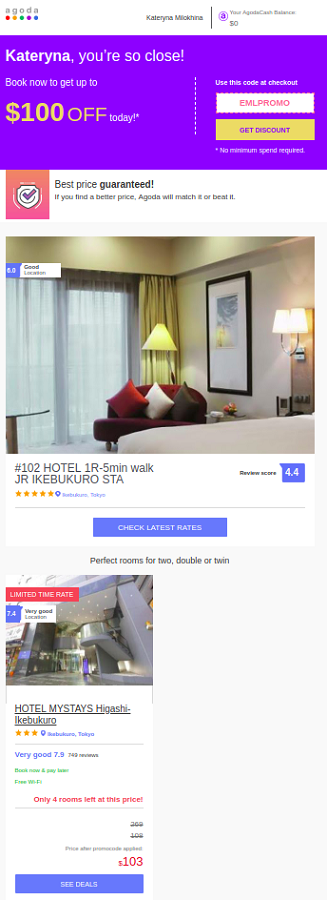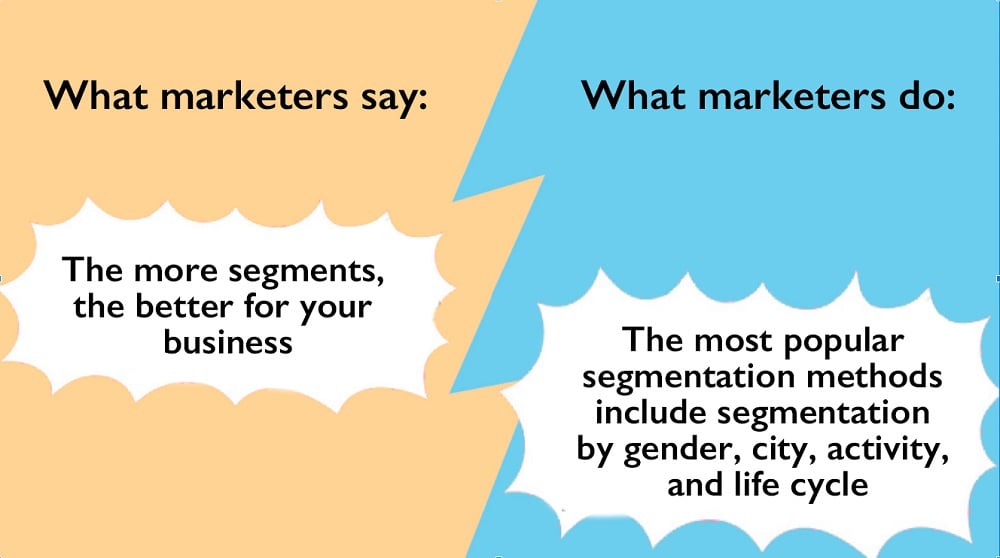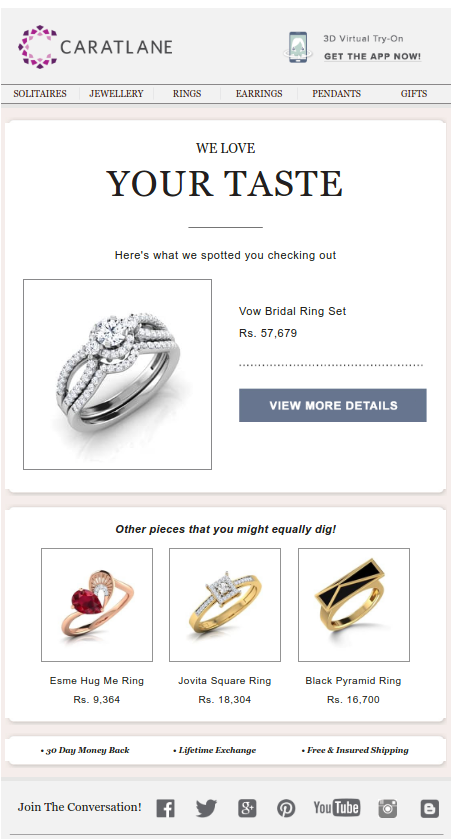How and Why Should You Segment Your Contact Database?
- What are contact database segments? How can you identify them?
- The tasks of segmentation
- How to understand whether a segment is worth the cost?
- Conclusion
Segmentation is what turns bulk mailing into effective marketing communications. A conversation is a dialogue, not a monologue. Segmentation is what helps you achieve that.
The conversation with your customers starts with you hearing them out, learning more about their interests and needs. After you do so, you can send them a marketing message that will answer their expectations, fully or partially. This can be achieved even by segmenting the contact list by gender: this way you’ll be able, for example, to recommend bags to the female part of your audience and backpacks to the male one. This will take you a step closer to personalizing your messages, even if a bit. Segmenting your contact list also increases your chances of getting higher conversion rates.
However, how can you use segmentation to its fullest? Here are some useful tips and techniques to help you effectively segment your contact database, by Dmitry Kudrenko, SEO of the eSputnik omnichannel marketing service.
What are contact database segments? How can you identify them?
A segment is a group of contacts from your total contact list that share one or a few characteristics in common. Here, the main task of a marketing professional is to identify the criteria that are strategically important for their business.
Usually, these criteria are the following:- the stages of the customer lifecycle;
- the customer’s activity in emails;
- the customer’s product preferences;
- the customer’s socio-demographic characteristics.
The stages of the customer lifecycle
The main goal of a marketing strategy is to nurture loyal customers that will buy from you again and again. However, loyal customers definitely aren’t the only ones you should pay attention to: your potential customers and those at risk of churning are also important. If you specify each segment’s features correctly, you can use communication to help customers move in-between different segments, therefore maximizing their lifetime value.
Conventionally, email marketing is tailored to the main stages of the customer lifecycle, starting from an email subscription offer and a series of welcome emails to new leads, to reactivation campaigns for the customers that are about to churn. Therefore, if you find it hard to set the formal characteristics for your lifecycle-based segments, start with implementing the best email marketing practices.
The customer’s activity
The customer's activity may depend on a lifecycle stage they are at the moment; however, this isn’t always the case. As a marketing professional, you need to pay attention not only to the customer's activity in browsing and purchasing products and services but also to their activity in communicating with you as well. How often does a customer open your messages? How often do they click on the links? Which communication channels do they prefer (email, SMS, messengers)? Answering these questions will help you build a better, more effective strategy.
The customer’s product preferences
Take for example: a travel agency can segment customers into the ones who like to go somewhere warm in winter and into the ones who like skiing. Each of these segments should be targeted with their own marketing campaign. In addition, you can use email marketing services that allow inserting personalized content for each segment automatically.

The customer’s socio-demographic characteristics
This is an easy one: you can segment your contact list by gender, location, age or occupation. This is the basic segmentation strategy that is used by almost every company.

The tasks of segmentation
Globally speaking, effective communication is the main goal of any marketing activity. However, if you want your customer communications to be effective, you need to pay attention to the intermediate objectives, such as automation and audience research. Segmentation can also help you with these objectives.
Automation
Rule-based segmentation will allow you to dynamically update segments with contacts that meet a certain condition or even a set of conditions. For instance, you can create a segment that will include the recipients who celebrate their Birthday in seven days: they will receive a promo email automatically. The segment will update automatically every day. If you’re tracking the purchase activity of your customers, you’ll be able to see which of the customers who received the email have redeemed your offer, and target them with a reminder a few days after the first email.

However, segmentation can be used to automate more complex processes as well. For example, you can create a segment using the customers’ behavioral characteristics: e.g., include contacts who’ve browsed products in category X on a type-Y gadget within the N period of time. As soon as a contact meets these requirements, they become a part of a segment and start receiving relevant triggered messages.

Of course, such micro-segmentation won’t be possible if you don’t have a lot of actionable data along with the ability to process this data in real time. In order to collect more relevant data, start using web-tracking tools that monitor the behavior of your website’s visitors. That said, the ability to process this data and gain timely, actionable insights will depend entirely on the technical capabilities of the marketing automation service you сhoose to use.
Research
Each segment is a dynamic portrait of one of your customer’s types. Monitoring these segments will allow you not only to improve the performance of your marketing campaigns but to strengthen your business model as well. In order to achieve that, you need to monitor the activity of different segments, do the cohort and the RFM analysis, come up with hypotheses and test them.
How to understand whether a segment is worth the cost?
It’s important not to overdo it when it comes to segmentation. Just imagine: you have three gender segments (men, women, not specified), three behavior-based segments and three geo-based segments. Therefore, you’ll have 27 segments that derive from these nine. Would it be wise to spend your resources on working with each of these segments? Probably not.
Before you create a new segment, try to answer the following questions:— Do you really have a unique offer for this particular segment?
— Will the segment include enough contacts to make your efforts worthwhile?
There is another simple and effective way to check if you’ve identified the right criteria for segmentation. Try to estimate the number of contacts the segment will have and then compare your expectations to reality. If the error is too big, try to adjust your criteria.
Conclusion
Picking the right criteria for a segment is key to effective segmentation. Identifying the right segmentation criteria, will help you target your customers with automated, personalized email campaigns, and always get the important insights for further business optimization.
TOP 10 Best Email Templates 2019
| Template Name | Theme Provider | Template Category | Price |
| SYNERGY - Responsive Newsletter Template | PennyBlackTemplates | Marketing Agency Templates | $14 |
| Tego - Responsive Email Template Newsletter Template | PennyBlackTemplates | Email Services Templates | $14 |
| Marketing - Responsive Newsletter Template | PennyBlackTemplates | Marketing Agency Templates | $17 |
| TopShop - Responsive Email Newsletter Template | evethemes | Fashion Templates | $17 |
| Wave - StampReady Builder + Responsive Newsletter Template | edrdesigner | IT Templates | $14 |
| Passion HTML Email + Online Builder Newsletter Template | DynamicXX | Email Services Templates | $19 |
| Black Friday - Email Newsletter Template | fourdinos | Fashion & Beauty | $14 |
| RKMail - Responsive Multipurpose Email Template + Stampready Builder Newsletter Template | rkarim247 | Marketing Agency Templates | $17 |
| BUCK - Responsive Email Template Newsletter Template | PennyBlackTemplates | Email Services Templates | $14 |
| Design Studio Responsive Newsletter Template | WT | Design Studio Templates | $14 |
Read Also
Premium Mobile Friendly & Responsive HTML Email Templates 2019
Email Marketing Usability: How to Optimize and Why You Should
Get more to your email
Subscribe to our newsletter and access exclusive content and offers available only to MonsterPost subscribers.




Leave a Reply
You must be logged in to post a comment.